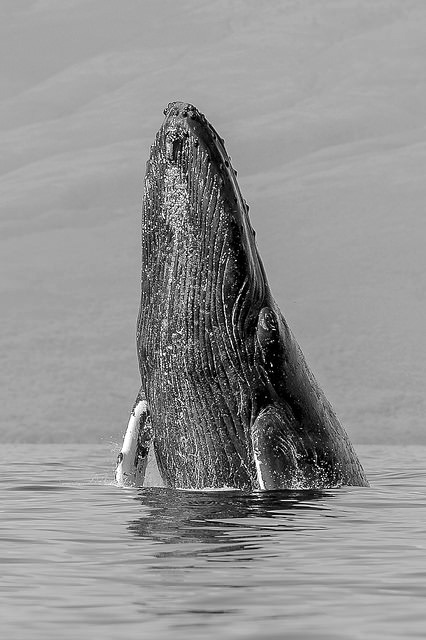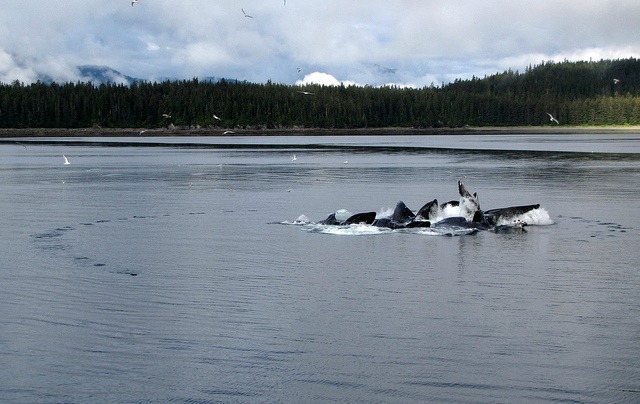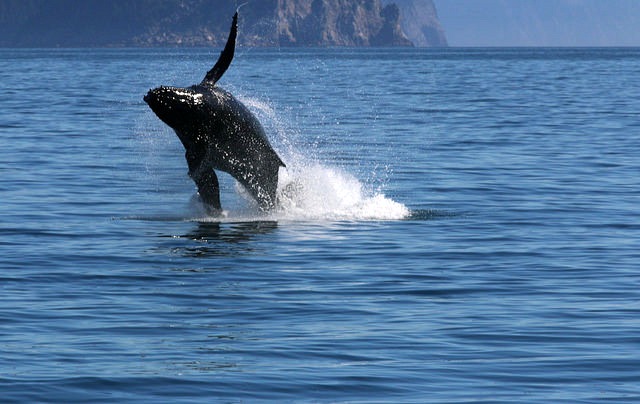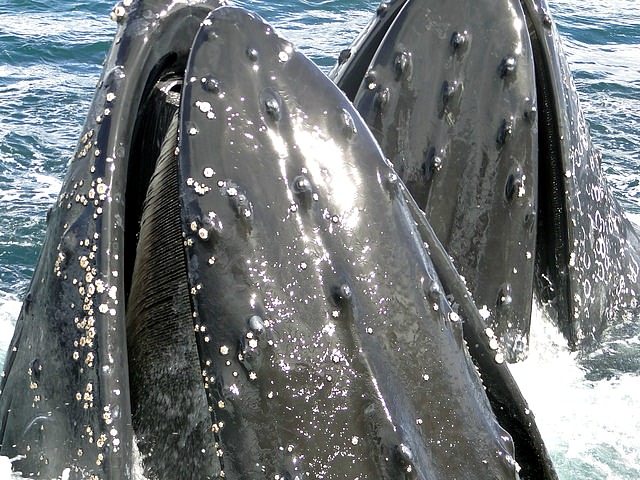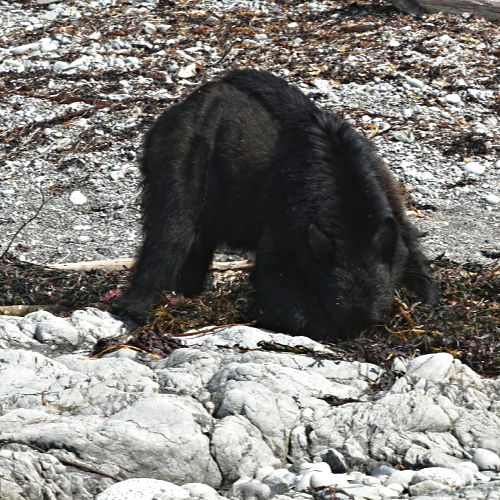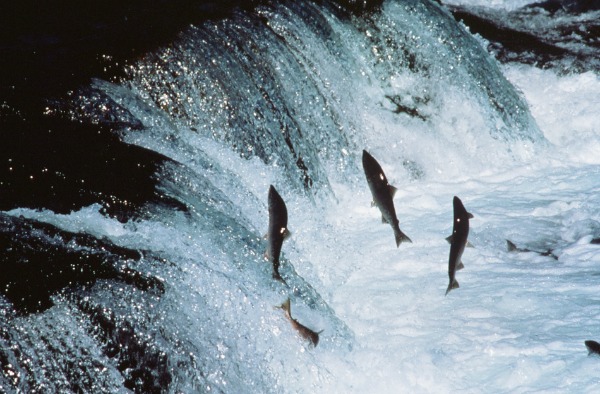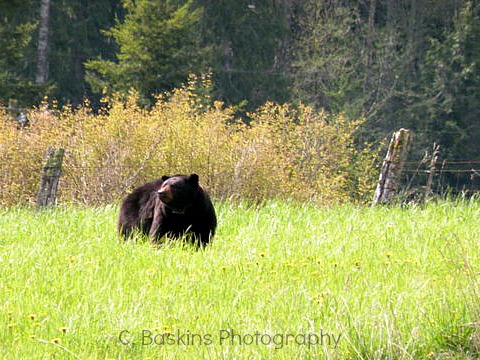Humpback Whale Facts
Humpback Whale Facts: Facilitating for you a wonderful whale watching cruise and better understanding and appreciation for humpbacks.
Not surprisingly, the Pacific Northwest is a great destination for whale watching enthusiasts. Among the many whale species to travel along our coastlines twice a year, the humpback whale is one of the most exciting to spot! (Below: photo credit: Flickr user Blair Haggerty under Creative Commons 2.0)
Take a Whale Watching Tour!
Whale watching is a favorite pastime in the Pacific Northwest, and seeing humpback whales may be a highlight of your own whale watching cruise.
Catch a tour from:
Anacortes | Port Angeles
Port Townsend | San Juan Islands
This page about humpback whale facts, and our orca whale page, are intended to enhance your whale watching experience. Enjoy!
Two Main Humpback Whale Populations
There are two main populations one can encounter off the Washington coast.
The California/Oregon/Washington group:
- Winters along Central American and Mexico coastlines
- Migrates for the summer and fall to waters that range from the California coast to southern British Columbia
The Central North Pacific group:
- Winters around the Hawaiian Islands
- Migrates during the warmer months to northern British Columbia and Southeast Alaska as well as into Prince William Sound
While these groups (along with a third - the Western Pacific group) may intermingle while travelling, they are still considered distinctive groups.
Among migratory mammals, these “gentle giants” win the prize for the longest migration. The longest recorded trip is 5,160 miles! But they don't waste any time along the way, in fact, closely studied routes between Alaska and Hawaii have shown humpbacks making the approximately 3,000 mile trip in as little as 36 days. During migration, humpbacks travel at a steady pace of 3-7 mph, staying close to the surface, and stopping rarely.
Humpback Whale Facts:
Unique Activity
It's quite the treat to catch a Humpback whale rise above the water's surface, and it's no surprise that they are a whale watching favorite, since they often put on an aerial show. Their frequent above water activities include:
- Breaching high out of the water
- Slapping the surface using fins, tails, or head, sometimes including twists.
- “Lobtailing,” or slapping the water's surface with their back tail only
It's not clear whether these activities are purposeful - to remove skin parasites or communicate with others, or merely just for fun. Lobtailing may be done as a warning to other whales.
Outside of their unique body shape, what first comes to mind when you think of well-known characteristics of the humpback whale? Quite possibly it would be their elaborate “singing.” These long vocalization patterns are a favorite activity of male humpbacks, and all males within a population will sing the same song in unison. Their song is usually complex, and may go on for 20 minutes and be heard up to 20 miles away! It might be repeated over and over for hours at a time. Though years of study have gone into humpback whale singing, not much is known about the activity. Many scientific observers believe it may have to do with mating or communication with their other pod members.
Humpback Whale Facts:
Physical Features
The Humpback whale is a “stockier” whale, possessing its trademark hump along the back. But where they might lack in long, sleek body shape, they make up for in their pectoral fins, which are about 1/3 of their total body size – the largest fins of all whale species. In fact, their scientific name (Megaptera novaeangliae) means “Big-winged New Englander” or “Great wings of New England”. These fins are very important to the Humpback, allowing them increased maneuverability; they can be used to slow their speed down or even go backwards.
The Humpback whale is a baleen whale. Instead of teeth, they possess baleen where teeth would be. Acting as a sieve, these plate-like bristles filter out water as the whale eats, while keeping in krill and other food. They have about 330 pairs of these bristles, divided into two rows, along their top and bottom jaws.
Above: These humpbacks are bubblenet feeding. They corral a school of herring by blowing a large ring of bubbles (visible in the photo above). The herring congregate in the center of the ring while the humpbacks swim upward within the bubble net, scooping up the hapless fish with mouths agape. Photo credit: Flickr user Doug Knuth under Creative Commons 2.0.
At first glance, Humpback whales may all seem to look alike, due to their plain dark gray color which is common among the species. But upon closer inspection, one can find characteristic patterns of color and markings under their flukes. Each of these patterns is so unique that they can be used for identification purposes, much like the human fingerprint.
Other humpback whale facts and physical features:
- Average weight for a Humpback adult is between 25-40 tons
- May have a length up to 60 ft, though a more common length is 40-50 ft
- Males are typically smaller than females, a common characteristic among baleen whales
- Lifespan average is 50 years; though they may live to be 100
- Flukes (tail fins) may reach 12 feet in width
Photo Credit: Flickr user Steve Miller under Creative Commons 2.0
Humpback Whale Facts:
Reproduction and Breeding
During winter, not a lot of feeding takes place, and the focus turns to mating. Humpback males are often quite competitive when it comes to selecting a mate, and will display aggressive behavior and activities. They may chase, thrash their back fins, and use vocalization to intimidate other males. It doesn't always stop there, however - physical confrontation, possibly leading to injury, can occur, and at least one resultant death has been recorded.
A female humpback whale is capable of breeding once every two years. The gestation period lasts about 11 months and a mother will birth in the warmest available water- typically shallow, near reefs, islands or the shore.
At birth, a newborn will weigh about 1 ton, and be 13-16 feet long. They grow rapidly, drinking 100 pounds of milk each day. Calves are weaned between 6-10 months of age. Mothers are very loving, and will keep a close eye on their calves, swimming near enough to occasionally touch them with their flippers.
Photo credit: Flickr user Rick Berg under Creative Commons 2.0
Cities Near Whale Populations
Whale watching cruises leave from each of these towns:
Additionally, look for humpback whales from the shore of First Beach in La Push, near Forks WA, during the months of March and April.
Remember these humpback whale facts as you enjoy viewing these enormous whales up close from a whale watching vessel!
Have you Gone Whale Watching?
Please Share Your Stories and Photos With Us!
Please Share Your Stories and Photos With Us!
Whale watching can be a spectacular, awe-inspiring experience! We'd love hearing about your whale watching happenings here on our website. Please share your stories along with some exceptional photos if you have them. We know that other visitors will enjoy these stories and seeing the photos as well!
Just click into the title box below and go from there. When published, you'll have "your own" page on MyPortAngeles which you can share with friends or anyone who asks!
We're happy to ensure professional and amateur photographers get credit for their work. Leave us your name in the form below, and means of contact, website, or FB page info so we can link back to you.

